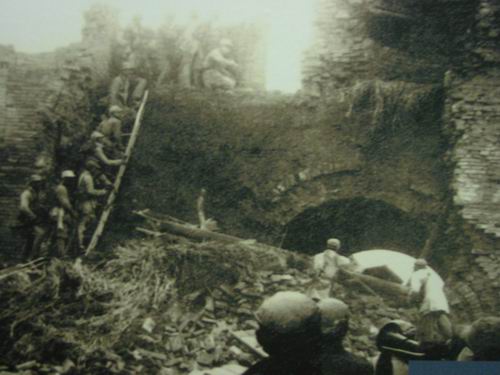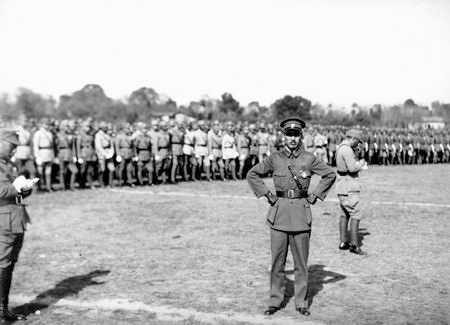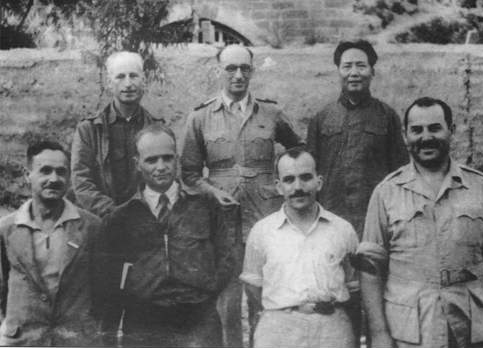|
Long March
The Long March ( zh, s=长征, p=Chángzhēng, l=Long Expedition) was a military retreat by the Chinese Red Army and Chinese Communist Party (CCP) from advancing Kuomintang forces during the Chinese Civil War, occurring between October 1934 and October 1935. About 100,000 troops retreated from the Jiangxi Soviet and other bases to a new headquarters in Yan'an, Shaanxi, traversing some . About 8,000 troops ultimately survived the Long March. After the defeat of the Red Army in Chiang Kai-shek's Fifth encirclement campaign against the Jiangxi Soviet, Fifth Encirclement Campaign, on 10 October 1934 the CCP decided to abandon its Jiangxi Soviet and headquarters in Ruijin, Jiangxi. The First Front Red Army of some 86,000 troops headed west, traveling over the rugged terrain of China's western provinces, including eastern Tibet. The Red Army broke several of Chiang's blockades with heavy losses, and by the time it crossed the Xiang River on 1 December had only 36,000 men left. Its lea ... [...More Info...] [...Related Items...] OR: [Wikipedia] [Google] [Baidu] |
Chinese Civil War
The Chinese Civil War was fought between the Kuomintang-led Nationalist government, government of the Republic of China (1912–1949), Republic of China and the forces of the Chinese Communist Party (CCP). Armed conflict continued intermittently from 1 August 1927 until Communist victory resulted in their total control over mainland China on 7 December 1949. The war is generally divided into two phases with an interlude: from August 1927 to 1937, the First United Front alliance of the KMT and CCP collapsed during the Northern Expedition, and the Nationalists controlled most of China. From 1937 to 1945, hostilities were mostly put on hold as the Second United Front fought the Second Sino-Japanese War, Japanese invasion of China with eventual help from the Allies of World War II. However, armed clashes between the groups remained common. Exacerbating the divisions within China further was the formation of the Wang Jingwei regime, a Japan-sponsored puppet government led by Wang ... [...More Info...] [...Related Items...] OR: [Wikipedia] [Google] [Baidu] |
Deng Xiaoping
Deng Xiaoping also Romanization of Chinese, romanised as Teng Hsiao-p'ing; born Xiansheng (). (22 August 190419 February 1997) was a Chinese statesman, revolutionary, and political theorist who served as the paramount leader of the People's Republic of China from 1978 to 1989. In the aftermath of Mao Zedong's Death and state funeral of Mao Zedong, death in 1976, Deng succeeded in consolidating power to lead China through a period of reform and opening up that transformed its economy into a socialist market economy. He is widely regarded as the "Architect of Modern China" for his contributions to socialism with Chinese characteristics and Deng Xiaoping Theory. Born in Sichuan, the son of landowning peasants, Deng first learned of Marxism–Leninism while studying and working abroad in France in the early 1920s through the Work-Study Movement. In France, he met future collaborators like Zhou Enlai. In 1924, he joined the Chinese Communist Party (CCP) and continued his studies in ... [...More Info...] [...Related Items...] OR: [Wikipedia] [Google] [Baidu] |
Bo Gu
Qin Bangxian, better known by his alias Bo Gu ( 4 May 1907 – 8 April 1946) was a Chinese senior leader of the Chinese Communist Party and a member of the 28 Bolsheviks. Early life and education Qin was born in Wuxi, Jiangsu, in 1907. In his earlier years, Qin studied at the Suzhou Industrial School where he took an active role in activities against imperialism and the warlords tyrannising China. In 1925 Qin entered Shanghai University, a university that was known for its impact on young revolutionists at the time. The ideas of Marxism and Leninism were taught there by early leaders of the Chinese Communist Party (CCP) like Qu Qiubai and Deng Zhongxia. Qin showed a great interest in these teachings. Later that year, Qin joined the May 30th Movement which called for protests and boycotts against imperialism. This was a precursor to his involvement in the CCP. In 1926 Qin was sent to the Moscow Sun Yat-sen University in Moscow, Russia where he continued to study both Marxis ... [...More Info...] [...Related Items...] OR: [Wikipedia] [Google] [Baidu] |
Communist International
The Communist International, abbreviated as Comintern and also known as the Third International, was a political international which existed from 1919 to 1943 and advocated world communism. Emerging from the collapse of the Second International during World War I, the Comintern was founded in March 1919 at a congress in Moscow convened by Vladimir Lenin and the Communist Party of the Soviet Union, Russian Communist Party (Bolsheviks) (RCP), which aimed to create a new international body committed to revolutionary socialism and the overthrow of capitalism worldwide. Initially, the Comintern operated with the expectation of imminent proletarian revolutions in Europe, particularly Germany, which were seen as crucial for the survival and success of the Russian Revolution. Its early years were characterized by attempts to foment and coordinate revolutionary uprisings and the establishment of disciplined communist parties across the globe, often demanding strict adherence to the "Twe ... [...More Info...] [...Related Items...] OR: [Wikipedia] [Google] [Baidu] |
Xiang River
The Xiang River is the chief river of the Lake Dongting drainage system of the middle Yangtze, the largest river in Hunan Province, China. It is the second-largest tributary (after the Min River) in terms of surface runoff, the fifth-largest tributary by drainage area of the Yangtze tributaries. The river flows generally northeast through the provinces of Guangxi and Hunan, its tributaries reaching into Jiangxi and Guangdong. Traditionally, it was regarded that the West (left) Branch is the Main Stream of the Upper Xiang, which rises in the '' Haiyang Mountains'' between Xing'an and Lingchuan counties of Guangxi. In the 1st national water census of China in 2011, the East Branch Xiao River,湘江源头在湖南蓝山, 湘江干流全长948公里, 流域面积94,721平方公里 - When the source stream of the Xiang is the Xiao, beginning in Lanshan County, the main river of the Xiang has a length of with a drainage basin area of :hn.xinhuanet.como was identified as the ... [...More Info...] [...Related Items...] OR: [Wikipedia] [Google] [Baidu] |
Tibet
Tibet (; ''Böd''; ), or Greater Tibet, is a region in the western part of East Asia, covering much of the Tibetan Plateau and spanning about . It is the homeland of the Tibetan people. Also resident on the plateau are other ethnic groups such as Mongols, Monpa people, Monpa, Tamang people, Tamang, Qiang people, Qiang, Sherpa people, Sherpa, Lhoba people, Lhoba, and since the 20th century Han Chinese and Hui people, Hui. Tibet is the highest region on Earth, with an average elevation of . Located in the Himalayas, the highest elevation in Tibet is Mount Everest, Earth's highest mountain, rising above sea level. The Tibetan Empire emerged in the 7th century. At its height in the 9th century, the Tibetan Empire extended far beyond the Tibetan Plateau, from the Tarim Basin and Pamirs in the west, to Yunnan and Bengal in the southeast. It then divided into a variety of territories. The bulk of western and central Tibet (Ü-Tsang) was often at least nominally unified under a ser ... [...More Info...] [...Related Items...] OR: [Wikipedia] [Google] [Baidu] |
First Front Red Army
The history of the People's Liberation Army began in 1927 with the start of the Chinese Civil War and spans to the present, having developed from a peasant guerrilla force into the largest armed force in the world. Historical background Throughout the centuries, two tendencies have influenced the role of the military in national life, one in peacetime and the other in times of upheaval. In times of peace and stability, military forces were firmly subordinated to civilian control. The military was strong enough to overcome domestic rebellions and foreign invasion, yet it did not threaten civilian control of the political system. In times of disorder, however, new military leaders and organizations arose to challenge the old system, resulting in the militarization of political life. When one of these leaders became strong enough, he established a new political order ruling all China. After consolidating power, the new ruler or his successors subordinated the military to civilia ... [...More Info...] [...Related Items...] OR: [Wikipedia] [Google] [Baidu] |
Ruijin
Ruijin () is a county-level city of Ganzhou in the mountains bordering Fujian Province in the south-eastern part of Jiangxi Province. Formerly a county, Ruijin became a county-level city on May 18, 1994. It was an early center of Chinese communist activity and developed a reputation as cradle of the Chinese revolution. In the late-1920s, the Nationalists forced the Communists out of the Jinggang Mountains, sending them fleeing to Ruijin and the safety of its relative isolation in the rugged mountains along Jiangxi-Fujian border. In 1931, Mao Zedong founded the Chinese Soviet Republic (CSR) with Ruijin as its capital; it was called Ruijing by the CSR. The Communists withdrew in 1934 on the Long March after being surrounded again by the Nationalists. During the Cultural Revolution, the Ruijin Massacre in September and October 1968 killed over 300 people in the county. Ruijin is a popular destination for red tourism and ecotourism. It is a pilgrimage for Maoists from China an ... [...More Info...] [...Related Items...] OR: [Wikipedia] [Google] [Baidu] |
Fifth Encirclement Campaign Against The Jiangxi Soviet
The Fifth Encirclement Campaign against the Jiangxi Soviet), while the Chinese Red Army, Communists described it as the fifth counter-encirclement campaign at the Central Soviet ( zh, c=中央苏区第五次反围剿, p=zhōngyāng Sūqū dì wǔ cì fǎnwéijiǎo), also known as the fifth counter-encirclement campaign at the Central Revolutionary Base ( zh, c=中央革命根据地第五次反围剿, p=Zhōngyāng gémìng gēnjùdì dì wǔ cì fǎnwéijiǎo) or simply the fifth extermination campaign. was a series of military operations undertaken during the Chinese Civil War, spanning from 25 September 1933 to October 1934. The conflict pitted the forces of Chiang Kai-shek's Kuomintang, Chinese Nationalist Party (Kuomintang) against the Chinese Communist Party, Chinese Communists. Unlike earlier attempts to crush the Chinese Soviet Republic, the fifth campaign was marked by a more methodical strategy. Chiang Kai-shek implemented a policy of gradual advance fortified by the ... [...More Info...] [...Related Items...] OR: [Wikipedia] [Google] [Baidu] |
Shaanxi
Shaanxi is a Provinces of China, province in north Northwestern China. It borders the province-level divisions of Inner Mongolia to the north; Shanxi and Henan to the east; Hubei, Chongqing, and Sichuan to the south; and Gansu and Ningxia to the west. Shaanxi covers an area of over with about 37 million people, the 16th-largest in China. Xi'anwhich includes the sites of the former capitals Fenghao and Chang'anis the provincial capital and largest city in Northwest China and also one of the oldest cities in China and the oldest of the Historical capitals of China, Four Ancient Capitals, being the capital for the Western Zhou, Western Han, Sima Jin, Jin, Sui dynasty, Sui and Tang dynasty, Tang List of Chinese dynasties, dynasties. Xianyang, which served as the capital of the Qin dynasty (221–206 BC), is just north across the Wei River. The other Prefectures of China, prefecture-level prefecture-level city, cities into which the province is divided are Ankang, Baoji, Hanzho ... [...More Info...] [...Related Items...] OR: [Wikipedia] [Google] [Baidu] |
Yan'an
Yan'an; ; Chinese postal romanization, alternatively spelled as Yenan is a prefecture-level city in the Shaanbei region of Shaanxi Province of China, province, China, bordering Shanxi to the east and Gansu to the west. It administers several counties, including Zhidan County, Zhidan (formerly Bao'an), which served as the headquarters of the Chinese Communist Party (CCP) before the city of Yan'an proper took that role. Yan'an was near the endpoint of the Long March, and became the center of the Chinese Communist Revolution from late 1935 to early 1947. Chinese communists celebrate Yan'an as the birthplace of the revolution. As of 2019, Yan'an has approximately 2,255,700 permanent residents. History Yan'an was populated at least as early as the Xia dynasty, when it formed part of . The area was not part of the subsequent Shang dynasty, and was instead inhabited by the Guifang, who fought against the Shang dynasty. The area was later inhabited by the Quanrong and the Xianyun dur ... [...More Info...] [...Related Items...] OR: [Wikipedia] [Google] [Baidu] |
Jiangxi Soviet
The Jiangxi Soviet, sometimes referred to as the Jiangxi-Fujian Soviet, was a soviet area that existed between 1931 and 1934, governed by the Chinese Communist Party (CCP). It was the largest component of the Chinese Soviet Republic and home to its capital, Ruijin. At the time, the CCP was engaged in a rural insurgency against the Kuomintang-controlled Nationalist Government as part of the Chinese Civil War. CCP leaders Mao Zedong and Zhu De chose to create the soviet in the rugged Jinggang Mountains on the border of Jiangxi and Fujian because of its remote location and defensible terrain. The First Red Front Army successfully repulsed a series of encirclement campaigns by the Kuomintang's National Revolutionary Army (NRA) during the first few years of the Soviet's existence, but they were eventually defeated by the NRA's fifth attempt between 1933 and 1934. After the Jiangxi Soviet was defeated militarily, the CCP began the Long March towards a new base area in the nor ... [...More Info...] [...Related Items...] OR: [Wikipedia] [Google] [Baidu] |








